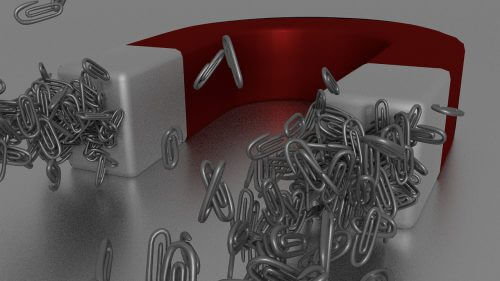The scientists of the Weizmann Institute of Science succeeded in creating and accurately measuring a kind of "magnetic monopole" (unipolar magnet). The findings, recently published in the scientific journal Nature Physics, reveal new and surprising details about the formation of spontaneous electric currents and magnetic fields in topological materials.

 Electron currents moving at the edges of graphene without time limit and without losing energy, were measured using a quantum interference device of superconductors at the tip. Scale bar: 500 nm
Electron currents moving at the edges of graphene without time limit and without losing energy, were measured using a quantum interference device of superconductors at the tip. Scale bar: 500 nmWhile there is no significant difficulty in separating a positive electric charge from a negative charge, it is impossible in nature to separate the two poles of a magnet. However, Weizmann Institute of Science scientists managed to create and accurately measure a kind of "magnetic monopole" (unipolar magnet). The findings thatwere published recently In the scientific journal Nature Physics, new and surprising details are revealed about the formation of spontaneous electric currents and magnetic fields in topological materials.
In a series of experiments, research student Aviram Uri, Dr. Samir Grover and other researchers in the research group of Prof. Eli Zaldov In the condensed matter physics department, in "topological material" - material which, in whatever way it is shaped, cut or burned, will always be insulated "inside" and conductive "outside". In theory, topological materials should add a surprising twist to a phenomenon known from ordinary metals: when a low electric charge is placed above the surface of a metal, a cloud of particles with an opposite charge will gather below the surface. In metals, both charges are electric, but the unique properties of certain topological materials may, according to the theory, cause in this case a reaction that mimics a magnetic, rather than an electric, monopole that forms near the surface. "Despite many attempts, this reaction was not discovered in the experiments," says Prof. Zeldov, "because there was no way to measure effects on such a tiny scale."
But Prof. Zeldov has a way to measure such an effect: a system developed in his laboratory - a "quantum interference device of superconductors at the tip of a tip" known as SQUID-on-tip or SOT - is an extremely sensitive magnetometer with nanometer resolution. To measure the effect in question, the members of the research team used a "trick": they placed the electric charge on the tip of the tip and measured the tiny magnetic response using the same system.
Although they were predicted already 30 years ago, until now, in most cases, these phenomena have been ignored. Now, in light of our experiments, physicists dealing with topological states may need to consider a more complex picture of these quantum effects."

In collaboration with Dr. Youngwook Kim and Prof. Jürgen Smet from the Max Planck Institute for Solid State Research in Stuttgart, Germany, the researchers applied a large external magnetic field to graphene - a two-dimensional sheet of carbon atoms - thus causing a quantum Hall effect, which turned graphene into a material topological of a certain type. Then, using the SOT system, they discovered that they could indeed create and measure a magnetic 'mirror image' in response to an electric charge near the graphene surface. Similar to the opposite electric charge illusion, the origin of the magnetic phenomenon they received is in the electrons inside the material, but it behaved like the "real thing". "We have demonstrated that two phenomena - electricity and magnetism - which are usually not connected in this way, intersect in topological materials," says Prof. Zeldov.
How does this happen? To understand the research observation, one must understand a certain phenomenon in the quantum Hall effect: it is possible to transfer matter between topologically isolated states and metallic states by changing the density of the electrons. In the topological state of graphene, the electrons flow along the edges, and the researchers discovered that these currents exist even without an external electric field, and they move indefinitely and without losing energy. These experiments revealed something that, at first, was a surprise: "In the quantum Hall state, it is expected that the currents will be chiral - that is, they will move in one direction and in several parallel channels along the edges," says Prof. Zeldov. "But we found in each channel a pair of currents spreading in opposite directions side by side and stemming from different sources - one topological and the other non-topological."

An extensive theoretical analysis of these results, in collaboration with Dr. Cyprian Lewandowski of the Massachusetts Institute of Technology (MIT), sheds new light on this puzzle. In the topological state, the currents move so that the electron movements produce a response in the form of a "magnetic monopole" below the surface. But in the non-topological (metallic) state, the currents move in the opposite direction, creating an opposing magnetic field that mimics a dipole magnet.
"Although they were discovered 30 years ago," says Prof. Zeldov, "so far, in most cases, these phenomena have been ignored. Now, in light of our experiments, physicists dealing with topological states may have to take into account a more complex picture of these quantum effects." These findings may have implications, among other things, for understanding quantum heat transport and for developing instruments for measuring quantum resistance with high precision.
Dr. Kusik Bagni, Nadav Auerbach, Dr. Ella Lachman and Dr. Yuri Miasovidov from the Department of Condensed Matter Physics at the Weizmann Institute of Science also participated in the study.
More of the topic in Hayadan:
